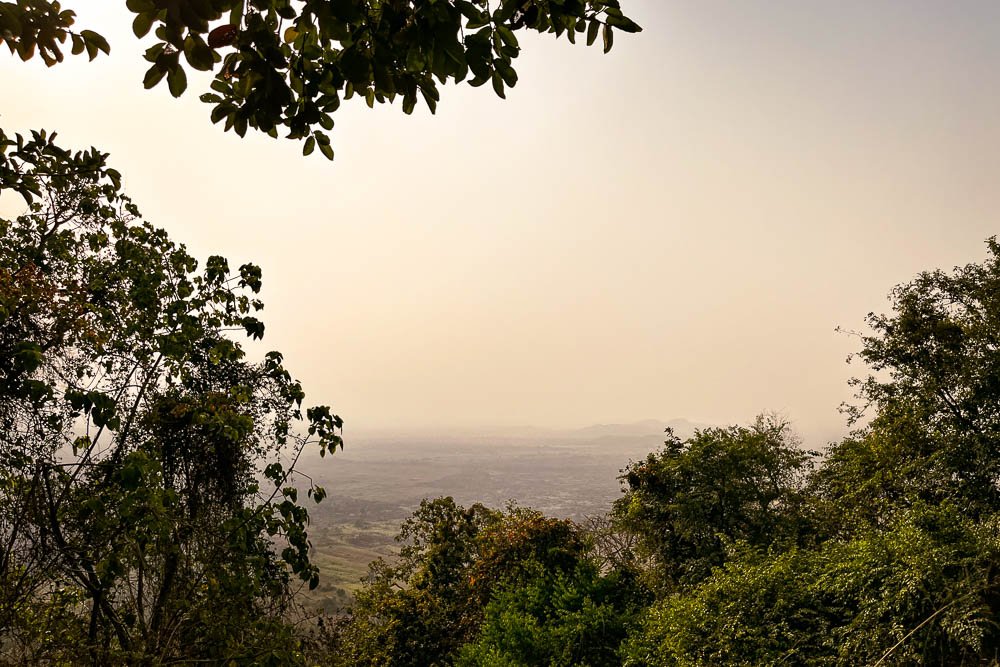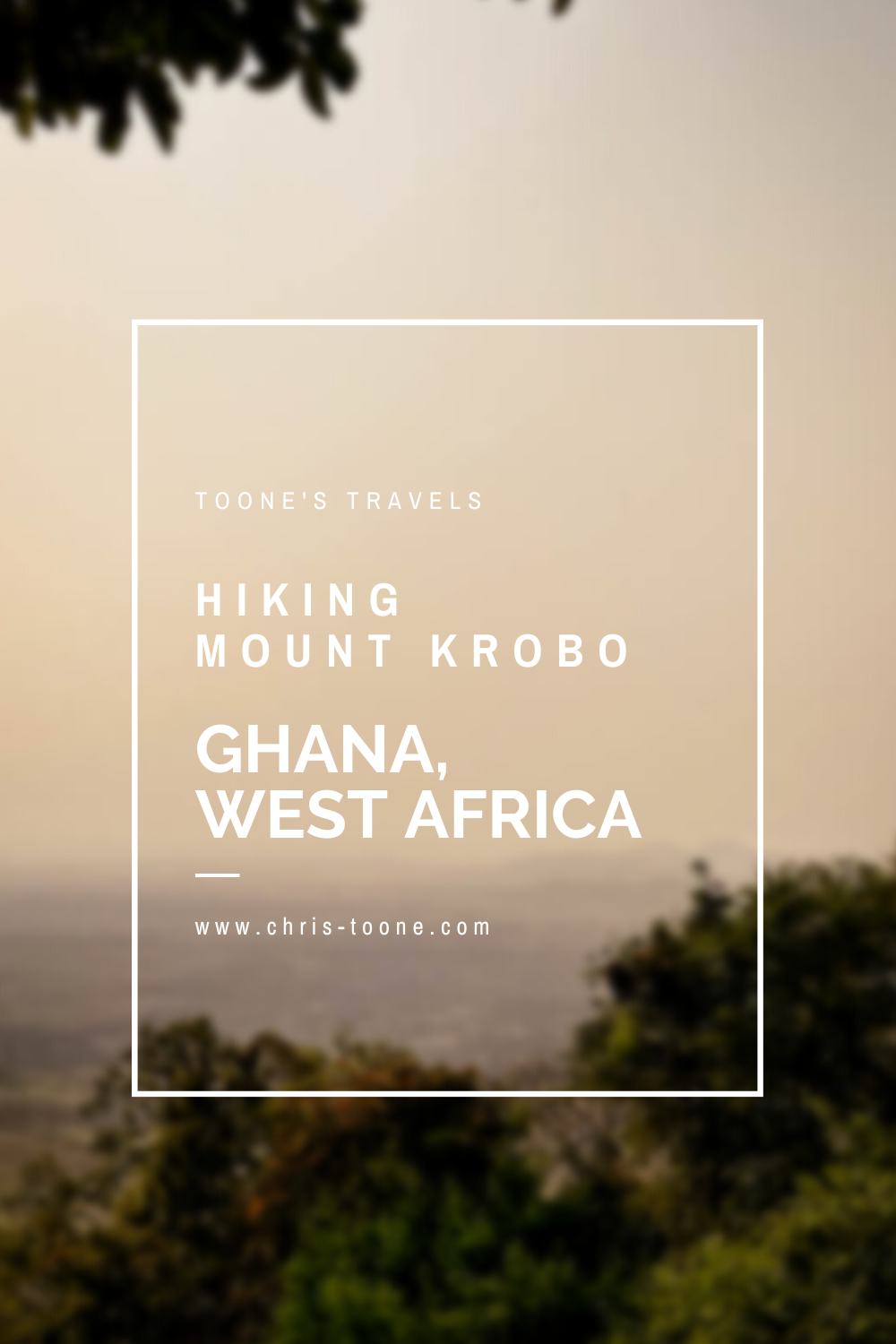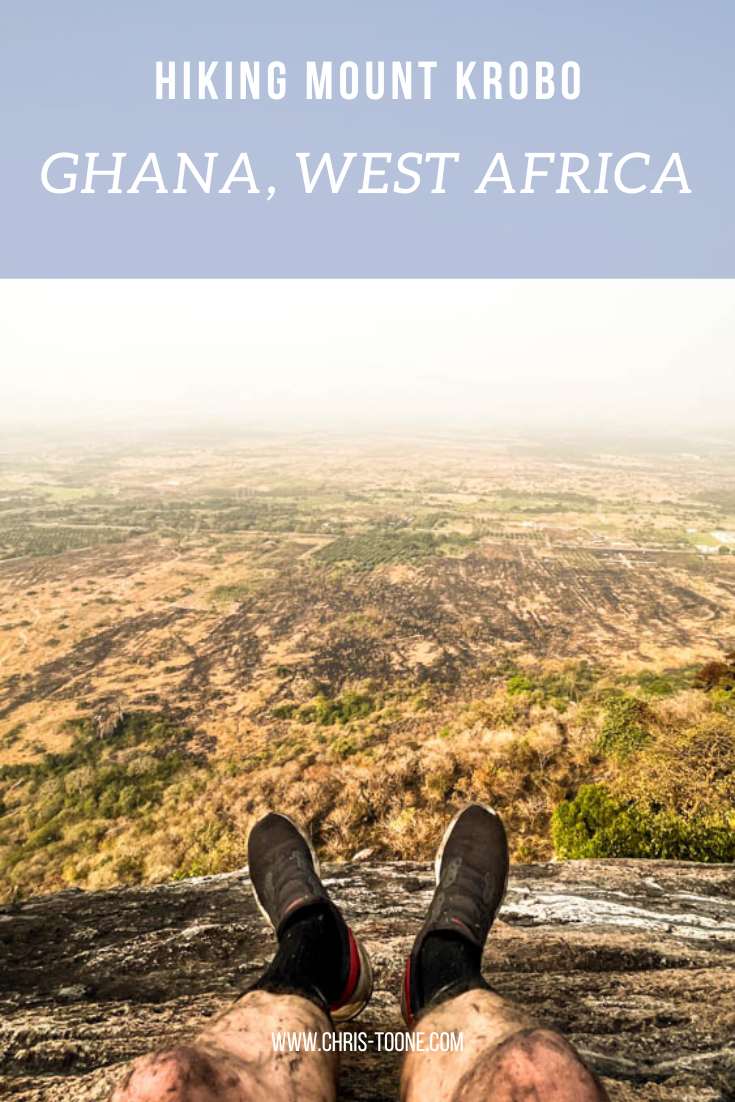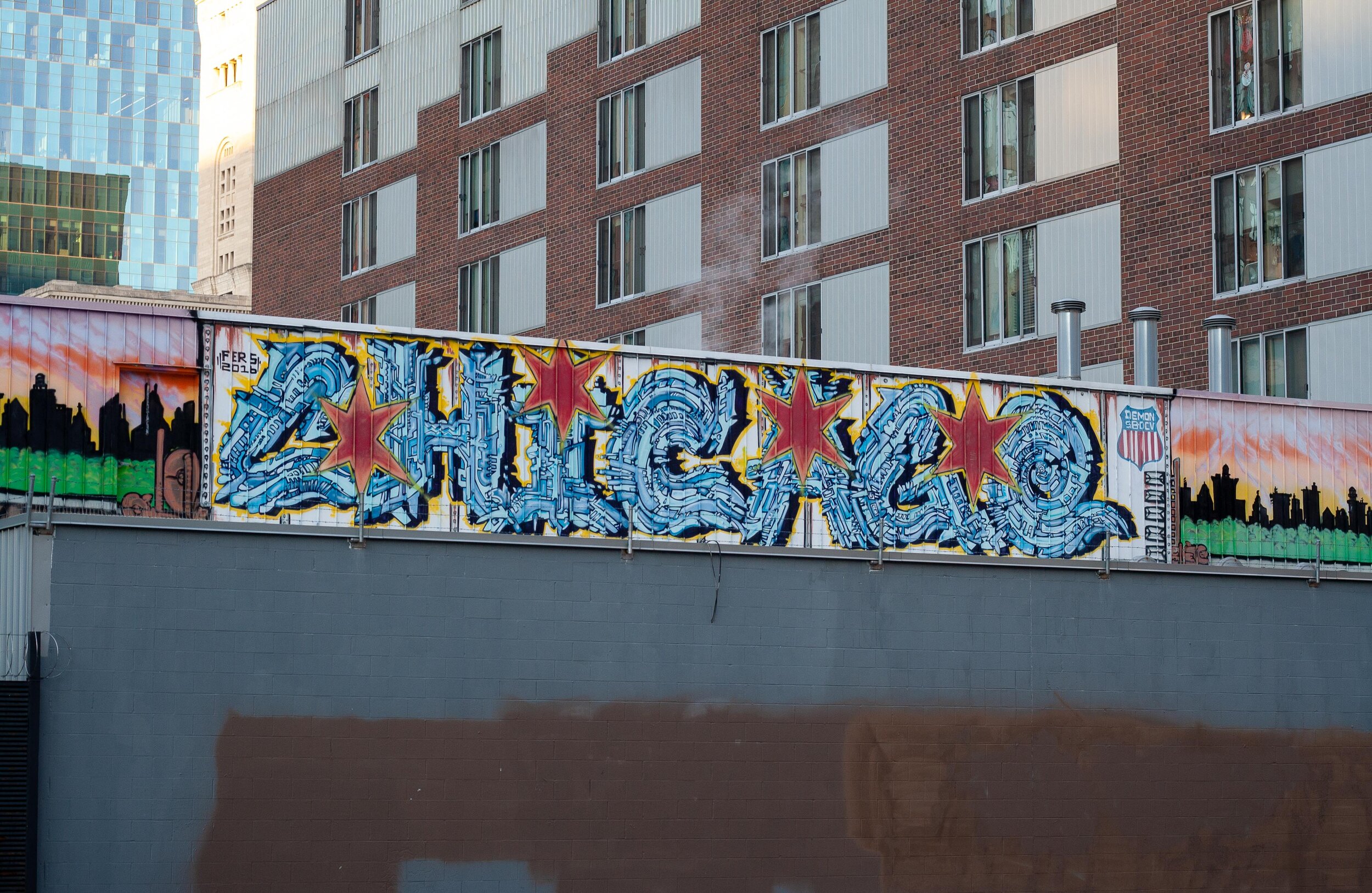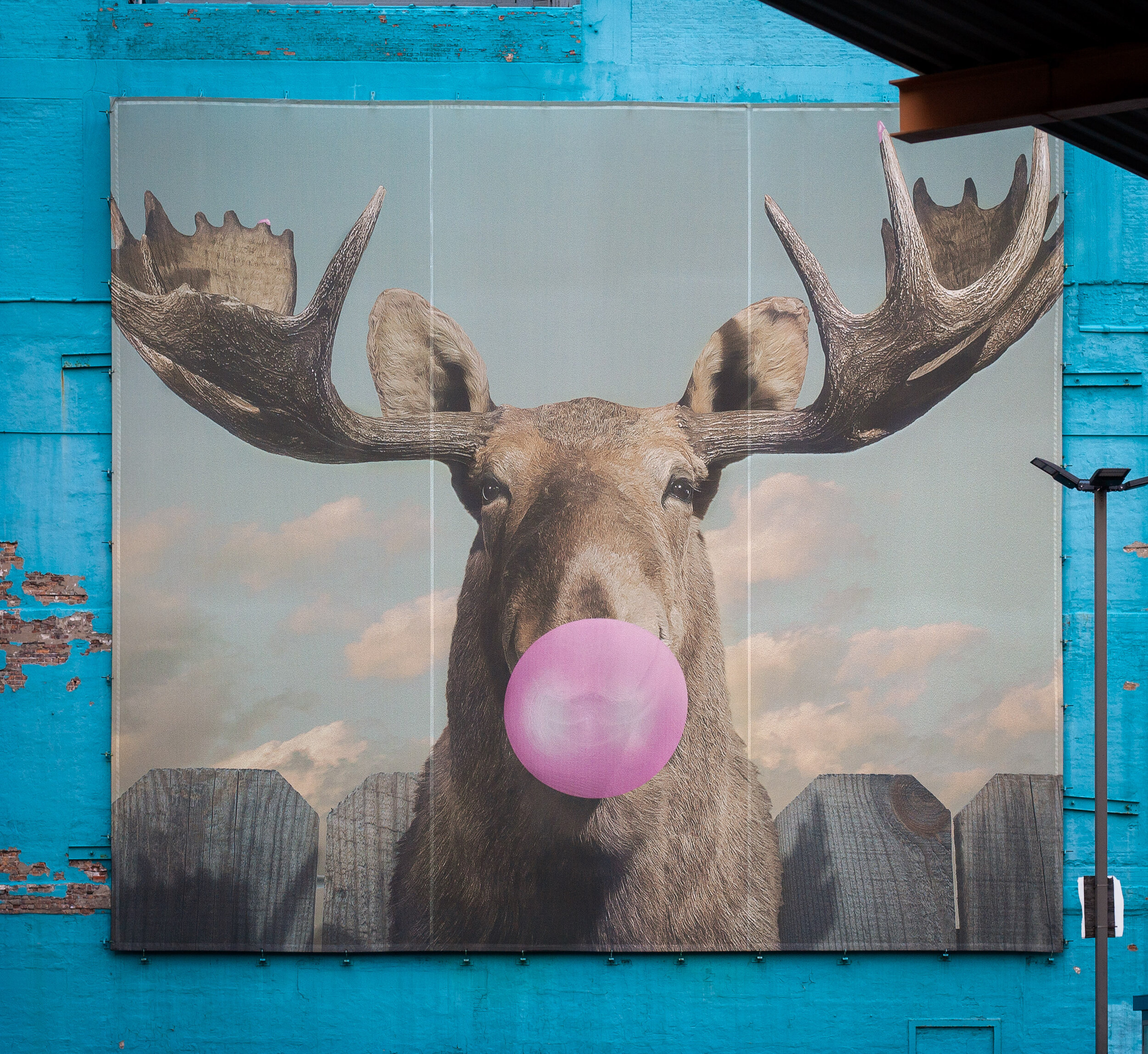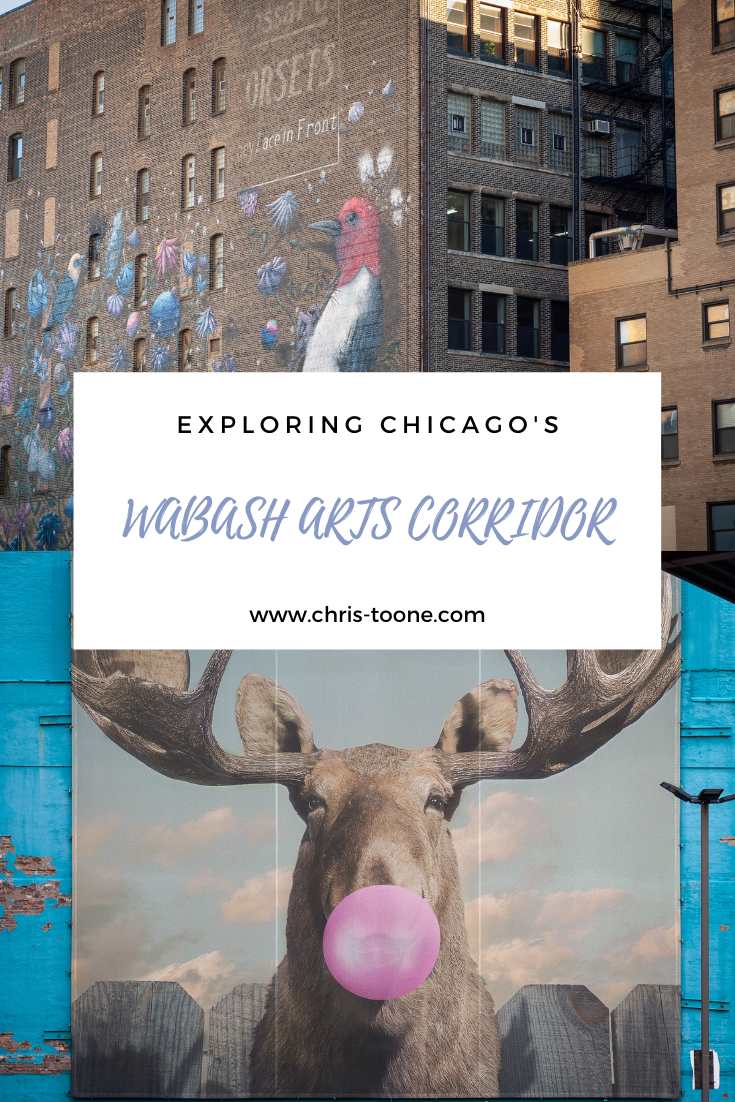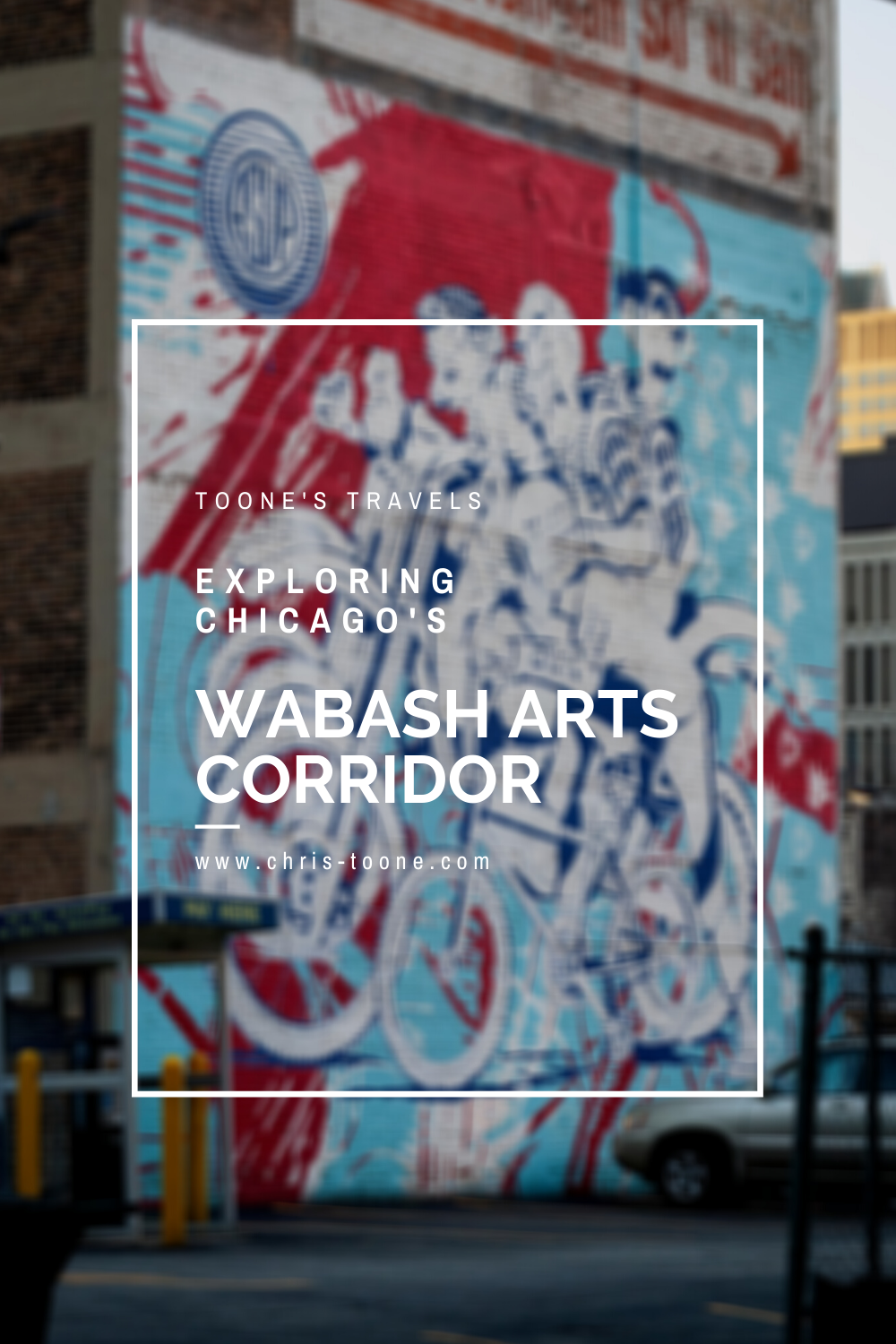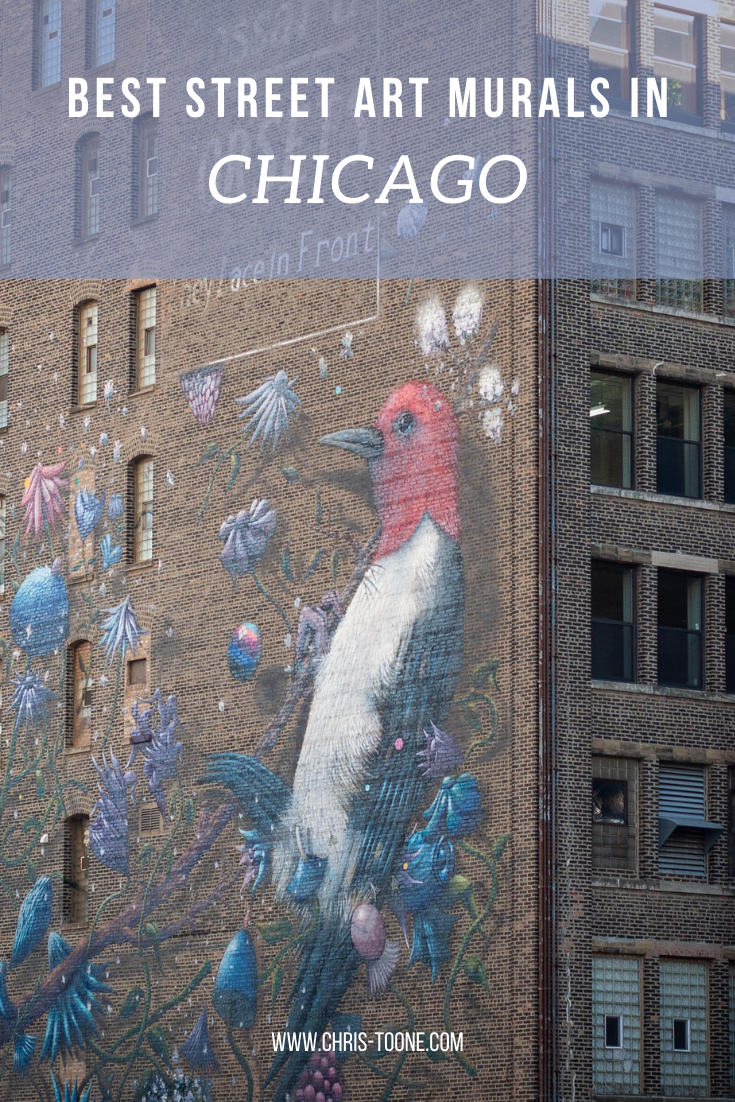Tagbo Falls: A Hiker’s Paradise in Liati Wote, Ghana
The Volta Region is home to some of the country’s most breathtaking natural beauty, and nestled in this lush landscape is Tagbo Falls—a hidden gem and my favorite under-the-radar destination in the area….
Note: All information below is updated as of October 2024, but as Ghana’s economy fluctuates so to can costs of guides, accommodations, etc.
Ten years. That’s the amount of time I've been traveling in and out of Ghana without having visited the Volta Region and I’ll be the first to admit, I had no idea what I was missing. Verdant mountains rising high along the border with Togo, coffee farms, waterfalls, and endless hiking trails are all at your fingertips.
The Volta Region is home to some of the country’s most breathtaking natural beauty, and nestled in this lush landscape is Tagbo Falls—a hidden gem and my favorite under-the-radar destination in the area.
Hiking to Tagbo Falls is a relatively easy trail with minimal elevation gain and few obstacles. The trail winds through the serene rainforest, cacao farms and, if you time it right, butterfly colonies fluttering along the path, all culminating at the stunning falls.
Take a swim, enjoy the afternoon in the forest, and make the most of this hidden gem.
View overlooking the mountains in the Volta Region of Ghana, from the top of Mount Afadjato
How to get to Tagbo Falls
Tagbo Falls is located in the village of Liati Wote, just at the base of Mount Afadjato, Ghana’s highest free-standing peak. To reach Liati Wote:
From Accra: It’s about a 3-4 hour drive (200 km). The most common route is via the Hohoe road. You can rent a car or take a tro-tro from Accra’s Tudu Station to Hohoe, then catch a taxi or motorbike to Liati Wote.
Through Golokwati: An alternative route is to take a tro-tro (local transportation) from Accra through Atimpoku and Juapong, towards Golokwati. Once there, jump on a local motorbike to take you the rest of the way (80 GHC, around USD 5.50) and enjoy the dirt roads as you wind towards the fresh air in the mountains.
Aerial view of Liate Wote, Ghana at sunset
Hiking to Tagbo Falls & what to expect
Note: Remember, this is West Africa which means it’s important to keep an eye out for trail hazards, including snakes, ants, and even land crabs.
The hike to Tagbo Falls is around 45 minutes to an hour each way, depending on your pace and how often you stop to soak in the surroundings. The trail itself is moderate in difficulty, with one or two steep sections that are completely manageable, unless it’s rainy season.
The trail starts at the same point as Mt. Afadjato, branching off to the right from the community park, and is marked the entire way.
Interested in exploring more of Ghana’s Volta Region? Check out these posts:
Here’s a breakdown of what to plan for:
Lush Rainforest: The hike takes you through a rich tropical rainforest, where you’ll encounter towering trees, vines, and an array of birds and butterflies. Keep your eyes peeled for other wildlife – the last time I was on this trail we unexpectedly came across a land crab. It’s tempting to try the cacao pods, but remember this is someone’s livelihood and it’s best to leave the trail as you found it.
Streams and Bridges: As you approach the falls, you’ll cross a series of small streams, all structurally sound and easily navigable.
The Waterfall: Once you arrive, you’ll be greeted by the spectacular 60-meter-high Tagbo Falls. The waterfall cascades into a cool, clear pool at the base, which is perfect for a refreshing swim after the hike. Surrounded by the dense forest, the falls creates one of the best secluded spaces in Ghana in relax and unwind. There’s a sign post stating “No Swimming” but, as the guides say, this is to deter people that don’t know how to swim from trying.
Guides and Entry Fees: Liati Wote is an unconventional tourist destination (yet extremely less visited than the description suggests). Guides are volunteer and required for all excursions. They make their money on tips provided. That said, it’s also possible to pay the trail fee, include a tip, and go guide-free on some of the more common trails, including Tagbo Falls. This gives a bit more flexibility and allows you to enjoy the waterfall as long as you want.
The entry fee to Mount Afadjato and Tagbo Falls is GHC 80 (USD 4.50) for both. This price drops if you visit just the waterfall. A common practice is to tip 40-50 cedis per guide.
The swimming hole at Tagbo Falls in Ghana makes for the perfect afternoon relaxation spot
Packing tips & tricks for Tagbo Falls
Hiking shoes: Essential for navigating the sometimes muddy and uneven trail, especially if it has recently rained.
Swimsuit and towel: For a refreshing dip in the cool waters of Tagbo Falls. My go-to quick dry towel is from Olympia Fit. Lightweight and reliable, get it here.
Note: There is nowhere to change by the waterfall other than in the forest. Washrooms and changing stalls can be found at the community park at the trailhead.
Water and snacks: Shops in Liati Wote are minimal, at best. It’s recommended to pack in everything you think you’ll need.
Camera: The scenery is stunning, and you’ll want to capture the moment!
Waterproof Bag: Be sure to protect your valuables from the streams and waterfall spray. It’s also useful as you never know when a storm will blow through the forest. Check out this one from Marchway — I never hike in Ghana without it and it keeps my camera gear dry!
Best time to visit Tagbo Falls
The best time to visit Tagbo Falls is during the rainy season (from April to October) when the waterfall is at its fullest. However, the trail can be slippery during heavy rains, so be sure to wear sturdy hiking boots and plan accordingly. The dry season (November to March) offers easier hiking conditions, but the waterfall might be less dramatic.
It’s hard to pass on the swimming hole at the base of Tagbo Falls
Places to stay near Tagbo Falls
While Liati Wote is a small village, there are several accommodation options nearby for travelers:
Wli Waterfalls Lodge: Located in Wli, about a 30-minute drive from Liati Wote, this cozy lodge offers comfortable rooms, delicious local meals, and easy access to both Wli and Tagbo Falls. A room here can cost between USD 20 and 40.
Afadjato Guesthouse: This simple guesthouse is located right in Liati Wote and is a great option if you want to stay close to the trailhead. It offers basic amenities and a friendly, local atmosphere.
Tagbo Falls Lodge: This is by far and away my favorite place to stay in Ghana. The eco-lodge is located in Liati Wote, adjacent to the guesthouse, and provides unparalleled meals from their organic garden at affordable prices. The phone network is limited, making it the perfect place to disconnect and unwind. A room here costs between USD 20 and 35. Be sure to book ahead of time as this is a popular retreat due to its limited hosting capacity. Be sure to try Madam Philomina’s stove-top bread with garlic butter!
Nearby Attractions
Mount Afadjato: If you’re feeling adventurous, why not tackle Mount Afadjato? It’s a short hike from Liati Wote, and reaching the summit offers stunning views over the Volta Region and even into neighboring Togo. There’s nothing better than a sunrise hike to the summit followed by an early morning swim at Tagbo on the way back to town.
Wli Falls: Just 30 minutes away, Wli Falls is another must-see waterfall. It’s the tallest in West Africa, and the hike to the lower falls is less challenging, making it easily accessible for all fitness levels. Additional options are available, including a more strenuous journey to the upper falls, skirting the border with Togo.
Amedzofe Canopy Walk: About an hour’s drive from Liati Wote leads to Amedzofe, Ghana’s highest elevated settlement. Here you’ll find untouched nature and one of the most picturesque canopy walkways, nestled in the mountains with Oti Falls flowing underneath. It’s definitely a spot worth checking out!
The sunlight makes a beautiful scene as it illuminates the top of the canopy above Tagbo Falls
It may sound extreme, but a visit to Tagbo Falls is the best way to experience one of Ghana’s most beautiful natural landscapes.
Whether you’re a solo traveler or exploring with friends, this adventure offers the perfect combination of challenge, reward, and tranquility.
So lace up your boots, pack your bags, and get ready for a day full of nature in the heart of the Volta Region!
In the meantime, stay safe & happy travels!
Have you hiked Tagbo Falls before? Share your experience in the comments!
Sharing is caring! Pin this post for later.
Exploring Mole National Park: Ghana’s Premier Wildlife Destination
Mole National Park is Ghana’s largest and most famous wildlife reserve, offering a breathtaking blend of savannah landscapes and diverse animal species. Located in the northern part of the country, it’s a haven for wildlife enthusiasts, photographers, and eco-tourists looking for an immersive safari experience...
Note: All information is up to date as October 2024 and is based around staying at the Mole Motel, however other accommodations exist within the park and are included in the post below.
Mole National Park is Ghana’s largest and most famous wildlife reserve. Located in the northern part of the country, it offers a breathtaking blend of savannah landscapes and diverse animal species. It’s a haven for wildlife enthusiasts, photographers, and eco-tourists looking for a unique safari experience.
After visiting Ghana for the past fifteen years and living here full-time for two, it’s a place that’s at the top of my list to not only bring visitors to but also myself to recharge and slow down!
An elephant is spotted on a morning game drive at Mole National Park in Ghana
History of Mole National Park
Established in 1958 and officially designated as a national park in 1971, Mole National Park covers approximately 4,849 square kilometers. It is home to over 90 mammal species, including elephants, buffalo, baboons, warthogs, and antelopes. Depending on the park ranger, you may even hear a tale about the elusive lions that some say still roam the expansive interior forests. The park also boasts nearly 300 bird species, making it a hotspot for birdwatchers.
One of the Mole’s unique features is its year-round accessibility and the chance to observe elephants up close, especially during the dry season when they frequent waterholes. As one of West Africa’s best-preserved wildlife reserves, Mole National Park continues to attract travelers looking for an authentic African safari experience in a less commercialized setting.
I’ve visited the park in January, April, August, and December and have never been disappointed with wildlife viewing. Warthogs roam the motel grounds and even elephants come to say ‘hello’ at times. Careful of the baboons, though. They’ve been known to steal your food at the restaurant and open your room if it’s not locked — speaking from experience.
An antelope is spotted in the morning glow at Mole National Park - Ghana, West Africa
How to get to Ghana’s Mole National Park
Mole National Park is located in northern Ghana, approximately 150 kilometers from Tamale, the capital of the Northern Region. There are several ways to get there:
By Air: The easiest way is to fly from Accra to Tamale Airport. From Tamale, a private vehicle can be arranged through your accommodations. Other options include a shared taxi or a bus to Mole, which takes around 3-4 hours. Note: things are spread apart in the northern areas of Ghana. The most efficient option is a private vehicle with driver that costs GHC 1,500 round trip.
By Road: For those who prefer road travel, buses operate from Accra, Kumasi, and other major cities to Larabanga, the nearest town to the park. From Larabanga, it’s a short ride to Mole National Park.
Don’t want to do the planning? Check out this 3-day tour to Northern Ghana!
Entrance and Accommodation at Mole National Park
The beauty of Mole National Park lies in its affordable rates compared to other safari destinations in Africa. The entry fees are as follows:
Ghanaian citizens: GHS 10–15 (approx. USD 1–2)
Non-residents: GHS 40–60 (approx. USD 4–6)
*Discounts apply for children and students
Vehicles: Vehicles must also pay a nominal entrance fee into the park. This is the case even if a driver is dropping you off and will pick you in a few days. A Ghana registered car will cost GHC 5.00.
Accommodation: Mole offers a variety of accommodation options to suit different budgets, all located within the park:
Mole Motel:
This budget-friendly option offers basic rooms and chalets with stunning views of the park’s watering holes, where elephants and other animals often gather. Rates start around USD 30–75 per night. A range of accommodations is available, from dorm rooms to chalets overlooking the watering hole.
Although basic and far from luxurious, most rooms include A/C and I can personally attest that they have made several improvements over the years. Plus, the whole point is to be outdoors and enjoy nature, right?
A restaurant and bar exists onsite and offers a wide variety of food, including pizzas, burgers, local foods, and even Chinese. If you’re looking for a truly northern Ghana experience, don't miss the guinea fowl. This tough meat is a Ghanaian favorite in that part of the country!
Mole Motel is a great place to bring a book, enjoy a Club beer, and relax by the pool while spotting elephants below. It’s one of my favorite places in Ghana to experience a sunset.
It’s not uncommon to see a family of warthogs grazing the grounds or elephants visiting the motel for breakfast! Sometimes the universe is in your favor and the wildlife comes to you.
Note: Although Mole Motel is listed as having wifi, the network is very unstable It works enough to send messages from your phone, depending on where you are, but I would not recommend coming here for remote work.
Zaina Lodge:
For those seeking a more luxurious experience, Zaina Lodge offers high-end accommodations with private tented chalets, an infinity pool, and premium services. Prices start at USD 300 per night and are inclusive of meals and game drives.
I haven’t stayed here because I prefer Mole Motel. Part of the charm of northern Ghana is the raw and remote wilderness, but I can see how a luxury place like this would be great for family vacations!
Camping:
For the more adventurous, camping facilities are available within the park near the ranger's station just outside of Mole Motel. You’ll need your own gear, and fees are approximately GHS 50 (USD 3) per night.
Mole Motel in Ghana as seen from the watering hole
What to expect at Mole National Park
Visiting Mole National Park provides an unforgettable safari experience without the crowds typical of other African reserves. The best times to visit are during the dry season (November to April), when animals congregate around water sources, making sightings easier.
Three of the most common activities in Mole National Park are walking safaris, game drives, and birdwatching:
Walking Safari:
Mole is one of the few national parks in Africa where you can go on a walking safari. Accompanied by armed rangers, you’ll explore the park on foot and get incredibly close to elephants, antelope, and more. Some level of fitness is required for this and it’s best to go early in the morning to avoid the heat.
If you don’t spot elephants on your trek, don’t worry. Rangers will happily take you back into the bush when they are spotted near the watering hole throughout the day (for an additional fee, of course).
The walking safaris are so cheap because all you pay for is a guide at an hourly rate (GHC 12 per hour for non-nationals). You read that right: a two-hour walking safari with elephants will cost you GHC 24, around USD 1.50. These occur at 7 am and 3:30 pm each day and no sign-up is required. Simply show up at the guard station!
Game Drives:
Open-top vehicle safaris offer a different perspective of the park, covering larger distances and giving you a better chance of spotting wildlife like warthogs, buffalo, and birds of prey.
There are day-time and night-time safari options, both with unique advantages. I’d recommend doing both as the drive in the dark gives unparalleled views of the stars and you’ll often see different animals such as bush babies, genet cats, owls, and more. If you’re lucky, maybe you’ll see an elephant both during the day and night!
For small children and those with fitness concerns, driving is the more comfortable and accessible option.
Compared to a walking safari, the game drives are a bit more expensive as you must pay both the guide and vehicle fees. A safari-vehicle rental fee for both day and night is GHC 200 per hour and a guide fee for non-nationals at night is GHC 40 per hour while daytime is GHC 12 per hour.
This means a two-hour game drive during the day will cost you GHC 424, around USD 25, and at night GHC 480, or USD 30. If you make friends at motel, share a vehicle and lower the costs by splitting the vehicle fee between people.
Similar to walking safaris, game drives occur at 7 am and 3:30 pm daily, while night drives take place from 7pm-9pm.
Note: Book your night safari early at the guard station. These must be reserved in advance to ensure a vehicle is available.
Birdwatching:
Mole is a paradise for birdwatchers, with species such as the white-backed vulture, martial eagle, and saddle-billed stork commonly spotted. Birdwatching tours are also available for those keen to explore the avian diversity and can be enquired through Mole National Park’s website.
A Woodland Kingfisher is spotted with an elephant in the background - Mole National Park, Ghana
Things to do near Mole National Park in Ghana’s Northern Region
Mole National Park is a gateway to several other exciting destinations in northern Ghana and many visitors pair it with a cultural trip to the surrounding areas. Don’t be surprised if you’re approached by a tour guide at the motel; this is common practice!
Larabanga Mosque:
Just a 20-minute drive from Mole, this ancient mosque is an architectural gem and holds significant religious and historical importance in Ghana. Visitors can take guided tours to learn about its fascinating history, and explore community projects in the village like the local school and a shea butter-making process.
Mognori Eco-Village:
Located just outside the park, this community-run initiative offers visitors the chance to experience traditional village life. You can take a canoe safari along the Mole River or enjoy a cultural drumming and dancing session with the locals.
Ready to explore more of Ghana’s natural beauty? Click here to get started!
Packing tips for Mole National Park
Make no mistake about it, although Mole National Park is a well-visited tourist destination, it’s still very remote and there are some important considerations when packing. Here’s what to bring:
Cash — Credit cards are accepted at the Mole Motel and Restaurant (network dependent), but it’s cash-only to pay the park rangers for the safaris. There’s also a small provisions and gift shop which is also cash-only. Stop at an ATM in Tamale and pull out enough money for your visit.
Medicine — You never know how your body will respond to different foods in remote areas. It’s best to pack basic medicines for stomach issues, allergies, and more. On one trip my friend was stung by a wasp, his eye swelled, and all we could do was “ice” it with the coldest water bottle we could find. There is a small health clinic in the nearby village within park borders, but don’t rely on this (speaking from experience)!
Warm Clothes — If visiting in December, it gets cold at night which means the morning and night game drives will require you to bring layers. It sounds odd given Ghana’s equatorial location, but trust me when I say the last thing you want is to be on top of a safari vehicle shivering for two hours.
Torch — When the sun goes down, it gets dark and the last thing you want to do is stumble upon a mother warthog grazing with her children. The grounds within the motel gates are small, but it’s still useful to have a torch to get back to your room after a few drinks at the bar to cap off a day of adventure.
Portable Charger - This comes in handy for multiple reasons. You won’t want your phone dying on a safari just when you track down an elephant. If you have the right model, it also serves as a hand warmer for those cool savanna mornings.
A hazy December sunset overlooking the watering hole at Mole National Park in Ghana
Mole National Park offers a unique and tranquil safari experience, perfect for travelers who want to immerse themselves in nature and observe wildlife in its natural habitat. Whether walking alongside elephants or watching a sunset over the savannah from the lodge, Mole promises a serene and unforgettable adventure. With its affordable prices, accessible location, and nearby cultural attractions, it’s an essential stop on any Ghana travel itinerary.
Ready to explore Ghana’s wild side? Start planning your Mole National Park adventure today and check out more posts about this incredible country below!
Sharing is caring! Pin this post for later.
Exploring the Wechiau Hippo Sanctuary in Ghana: Everything you need to know before you go
Tucked away in the Upper West Region of Ghana, the Wechiau Hippo Sanctuary offers visitors an extraordinary experience combining wildlife, culture, and scenic beauty. For nature lovers and adventure seekers alike, this off-the-beaten-path destination is a must-see during your trip to Ghana. Here’s everything you need to know about visiting the sanctuary...
Note: All information below is updated as of September 2024
Tucked away in the remote Upper West Region of Ghana, the Wechiau Hippo Sanctuary offers visitors an extraordinary experience combining wildlife, culture, and scenic beauty. For nature lovers and adventure seekers alike, this off-the-beaten-path destination is a must-see during your trip to Ghana. Here’s everything you need to know before you go.
History of the Wechiau Hippo Sanctuary
The Wechiau Hippo Sanctuary is a community-run conservation project, created to protect one of the last remaining populations of hippos in Ghana.
Established in 1999 in partnership with the Calgary Zoo, the sanctuary spans a 40-kilometer stretch along the Black Volta River, which forms part of the border between Ghana and Burkina Faso. Not only does it protect hippos, but it also preserves the surrounding savannah, woodland, and riverine ecosystems, while promoting sustainable tourism that benefits local communities.
Black Volta River from above
How to get to the Wechiau Community Hippo Sanctuary
The Wechiau Hippo Sanctuary is located about 85 kilometers from Wa, the capital of the Upper West Region. Visitors traveling from Accra or other major cities in Ghana can fly into Wa Airport, with a connecting domestic flight from Kotoka International Airport.
Passion Air is the only domestic airline to run the route and has only one daily flight except for Tuesdays and Saturdays. Tickets will cost you between USD 150-250.
It’s important to note that Ghana’s domestic flights aren’t immune to last-minute delays or cancelations but Passion Air is reputable for following through on rebooking and refunds.
Once in Wa, you can take a bus, shared taxi, or hire a private car to reach the sanctuary. The road from Wa to Wechiau is generally in good condition, but is not paved the entire way turning off the main road it will be dirt the rest of the way.
The drive is approximately 45min - 1 hour from Wa to the sanctuary reception. Once finished there, it’s another 45min drive through farming paths, heavy brush, and washed out “roads” to the riverbank.
If you find yourself on a whirlwind of a roadtrip through Northern Ghana like we were, then your best bet is to reach Wa from Tamale. This 4.5 hour drive is mostly on paved roads and takes you around the outer rim of Mole National Park, making it an easy trip to pair with the elephant safari and Larabanga Ancient Mosque if you have a few days.
A bloat of hippos spotted on the river
Cost of visiting the Wechiau Hippo Sanctuary
The entrance fee for the sanctuary is relatively affordable, and it directly supports the conservation efforts and local community. As of 2024, prices for non-residents hover around GHS 30–50 (approx. USD 3–5), while Ghanaian citizens may pay a reduced rate.
Additionally, guided tours of the sanctuary are available, costing around GHS 100–150 (USD 10–15) per group (this includes guide and boat fee).
Ready to learn more about Ghana? Check out these posts
Where to stay while visiting the Wechiau Hippo Sanctuary
Most accommodation options are in Wa. Two to consider are:
Dellagio Hotel: A welcomed site after a long couple days of driving. This hotel is comfortable, safe, and secure with a large outdoor space to relax and a restaurant with quality food. Wifi and breakfast are included. After learning the Lakeview Hotel was fully booked, we ended up here and although a little more expensive it was a great stay! A standard room will cost you GHC 565, approximately USD 35.
Kamara Lakeview Hotel: This is a newer hotel in Wa and isn’t fully completed yet, but the staff was very accommodating in referring us to Dellagio. The rooms are clean and comfortable, especially for GHC 394 per night, around USD 25.
Both of these hotels are located about 1 hour drive from the Wechiau Hippo Sanctuary.
At the sanctuary itself, a few options exist. For an authentic experience, consider staying overnight in a traditional homestay with a local family, which typically costs GHS 80–100 (USD 8–10) per night, or camp at the Hippo Hide and listen to the grunting at night as the animals make their way to land to feed. A basic guesthouse also exists near the riverside, with basic rooms starting at around GHC 100 per person, per night.
The banks of the Black Volta River, shot from Ghana and looking into Burkina Faso
What to expect at the Wechiau Hippo Sanctuary in Ghana’s Upper West Region
One of the sanctuary's main draws is the boat trip on the Black Volta River, where you can observe hippos in their natural habitat. Unlike typical wildlife safaris, this offers a more intimate and peaceful encounter with these majestic creatures. The best time to spot hippos is in the early morning or late afternoon, as they tend to retreat to the water to stay cool during the hottest part of the day. As on any safari experience, there’s never a guarantee to see the hippos. This is especially true during rainy season when the water level rises.
It’s important to note that there are multiple entry points onto the Black Volta, and the guides will take you to where they feel you have the highest chance of viewing hippos. Fortunately for us, the conservation team had just completed a census the day prior.
We drove my rusty Honda Pilot through small villages and dense brush before reaching the riverbank where a dugout canoe awaited. After donning our life vests we pushed away and were swiftly carried downstream by the strong current, immediately spotting a lone hippo in the distance.
After another few minutes of floating, we anchored to the tree branches as we flanked a bloat of hippos in the middle of the river. We had spoken to someone who had visited a week prior and after a few hours in a canoe they weren’t able to see any animals so needless to say this was unexpected. But there we were, fighting the current of the Black Volta, staring across the river into Burkina Faso, and viewing hippos in their natural habitat all the while one guide kept us steady and the other emptied water from the wooden floor.
It’s not always the most comfortable feeling being in canoe on a flooded river with one of the world’s most dangerous animals — we even had a rogue hippo leave the group and inch towards our spot, diving underwater and resurfacing closer than before — but our guides assured us that humans have never been attacked since the conservation area was established.
Besides hippo watching, the sanctuary is home to diverse bird species and other wildlife, including monitor lizards, crocodiles, and baboons. Nature walks with local guides allow you to explore the unique flora and fauna of the region, and for those interested in cultural experiences, visiting surrounding communities offers insight into the local way of life. The area is also known for its shea butter production.
Hippos spotted from canoe on the Black Volta River in Ghana
Nearby Attractions
While in the Upper West Region, consider extending your adventure by visiting some of the nearby attractions:
Wa Naa’s Palace – Located in Wa, this historic palace is the seat of the Wa Naa, the traditional ruler of the region. It’s an excellent spot to learn about the local culture and history. Note that the palace is still in use today so be sure to check in at the appropriate entrance.
Gbelle Game Reserve – Roughly 60 kilometers from Wa, this lesser-known game reserve is home to elephants, antelope, and various bird species. With that said, we dug through research to find more on this place and ultimately decided to pass on our drive north. No one in the area could tell us reliable information and there was no indication of the reserve on our route. We’ll definitely be going back to do more investigation. Hopefully you have better luck!
Gwolu Bone Setting Clinic - A little over 3 hours away from Wechiau is the unofficial border town of Gwolu. Here, one of the most frequented and last remaining traditional bone setting clinics is situated. This unassuming building draws in people from all over the north and even a few kilometers away from neighboring Burkina Faso in search of traditional treatment for fractures.
An aerial view of a bloat of hippos
The Wechiau Hippo Sanctuary is one of Ghana’s best-kept secrets, partially because it’s not the most accessible. If you’re willing to commit to the adventure, you’ll be spoiled by wildlife, culture, and stories to share. When planning a trip to Ghana, this is a “can’t miss” opportunity to discover a different side of the country’s natural wonders, and maybe even a quick trip across the river to unofficially reach Burkina Faso!
This is certainly and experience I won’t be forgetting anytime soon and is one of the most unique things I’ve been fortunate enough to do during my time in Ghana. It’s well worth the effort to reach there. So, what are you waiting for?
Sharing is caring! Pin this post for later.
Discover Ghana’s Hidden Gem: Amedzofe
Ghana is home to countless hidden gems, and one of its best-kept secrets is the town of Amedzofe. Nestled in the picturesque mountains of the Volta Region, this serene and welcoming town offers a perfect blend of natural beauty, history, and adventure. Whether you're a nature lover, a history buff, or simply seeking an off-the-beaten-path destination, Amedzofe has something special to offer...
Please note: All info below is accurate as of September 2024
Ghana is home to countless hidden gems, and one of its best-kept secrets is the town of Amedzofe. Nestled in the picturesque mountains of the Volta Region, this serene and welcoming town offers a perfect blend of natural beauty, history, and adventure. Whether you're a nature lover, a history buff, or simply seeking an off-the-beaten-path destination, Amedzofe has something special to offer.
Sounds like paradise, right? Here’s everything you need to know before a visit.
Canopy Walkway - Amedzofe, Ghana
History of Amedzofe
Amedzofe, the highest habitable settlement in Ghana, sits about 750 meters above sea level. Historically, it served as a strategic location for the Ewe people, providing a natural defense against attacks. During colonial times, German missionaries arrived and their influence is still visible today in the architecture, such as the iconic German-built Presbyterian Church. The area’s rich history is intertwined with its cultural heritage, making it a fascinating destination for those interested in learning about Ghana’s past.
How to get to Amedzofe
Amedzofe is approximately 2.5 to 3 hours by road from Accra, the capital of Ghana. Depending on traffic, it’s safer to plan for 4-5 hours of travel!
The best route is via the Accra-Ho road, which offers a smooth drive until you reach the scenic, winding roads that ascend the Amedzofe hills. Public transport is available, but if you're looking for convenience, renting a car or booking a private ride might be the best option.
The final stretch of the journey will treat you to breathtaking views of lush valleys, mountains, and distant villages.
If driving yourself, be aware that once entering Amedzofe the roads deteriorate. Mount Gemi is accessible, but many people choose to park elsewhere and take motobikes to the start of the canopy walkway, especially in rainy season.
Top things to do in Amedzofe, Ghana
Mount Gemi: One of the town’s main attractions is Mount Gemi, a prominent peak that offers panoramic views of the Volta Region. Atop the mountain stands a stone cross, erected by German missionaries in the early 20th century. A short hike to the summit (~20 minutes) will reward you with sweeping vistas of the surrounding landscape, including Lake Volta on a clear day.
At the top, you’ll find a cross that overlooks the village below. This is a sacred place to the community and it’s not uncommon to see people making pilgrimages to pray.
Cost: 55 GHS (USD 3.50) for foreigners
Note: Although Mt. Gemi is a hike, minimal fitness levels are required. Multiple routes of varying inclines exist, making this attraction suitable for everyone.
Amedzofe Canopy Walk: Amedzofe is home to a beautiful, lesser-known waterfall that cascades gently into a natural pool. The short but steep hike to the waterfall is an adventure in itself, as you pass through verdant forests and enjoy the peaceful sounds of nature. Don’t forget your camera and swimsuit—this spot is perfect for capturing the tranquil beauty of Ghana’s natural wonders and bathing below the falls.
If it’s between Kakum Canopy and Amedzofe, choose here. It’s far less trafficked and, as a result, the serenity of the surroundings are preserved.
Cost: 75 GHS (USD 4.75) for foreigners. Discounts applied for students.
Hours: The entrance building opens at 8am, 7 days a week. Get there early to have the entire place to yourself.
Note: There is a required level of fitness for this as the path to the canopy walk leads to a steep descent of 259 steps.
Explore Local Culture: Amedzofe is a culturally rich town, and visitors have the opportunity to interact with the friendly locals, learn about Ewe traditions, and explore the historical sites dotted around the town. The Presbyterian Church and old missionary quarters are great places to start, giving you a glimpse into the town's colonial past.
Birdwatching and Nature Walks: The area around Amedzofe is a haven for birdwatchers and nature lovers. The lush environment is home to a variety of bird species, including the colorful and rare African grey parrot. Guided nature walks can be arranged for visitors interested in learning more about the local flora and fauna through the local tourism board.
Canopy Walkway and Oti Falls, Amedzofe
Accommodation: Where to stay in Amedzofe
Accommodation is limited but affordable, with local guesthouses offering rooms for as little as GHS 100 (USD 8) per night. B
asic meals at local eateries will cost around GHS 15 to GHS 30 ($1 to USD 3), with more upscale options available in nearby towns like Ho.
Additionally, there are camping options, including equipment rentals, at Mt. Gemi.
Nearby Attractions
Less than an hour from Amedzofe lies the village of Liati Wote. This quiet spot near the border with Togo is another tranquil gateway into nature. Here you can climb Ghana’s tallest free-standing mountain (Mount Afadjato), hike to and swim at Tagbo Falls, or enjoy an afternoon eating some of the best food in the country at the Tagbo Falls Eco-Lodge as you relax in the courtyard. Another 45 minutes north leads to Wli, the home of West Africa’s tallest waterfall.
Other attractions:
Tafi Atome Monkey Village
Amedzofe, Ghana from above
Whether you’re hiking to the top of Mount Gemi, marveling at the cascading waterfall, or immersing yourself in local culture, Amedzofe is sure to leave a lasting impression. For those yearning for adventure and serenity, this charming town in the Volta Region promises to be a rewarding journey.
Pack your bags, hit the road, and leave the bustling streets of Accra, and the tourist trail, behind—Amedzofe awaits!
Sharing is caring! Pin this post for later.
Hiking Mount Krobo, Ghana: Everything You Need to Know
Within a week of regularly driving the Tema-Akosombo road, it was clear that one mountain towered above the rest: cue Mount Krobo. After weeks of trying to arrange a hike the plans finally panned out. Here’s everything you need to know for a great half-day adventure…
Please note: all info below is accurate as of January 2023
Having been to Ghana on and off for the past decade, my trips were isolated to the same stretch of road between Accra, Kumasi, and Berekum leaving the Eastern Region of the country an untouched landscape full of adventure.
Within a week of regularly driving the Tema-Akosombo road, it was clear that one mountain towered above the rest: cue Mount Krobo. After weeks of trying to arrange a hike the plans finally panned out.
Here’s everything you need to know for a great half-day adventure!
Hiking the base of Mount Krobo, Ghana
A brief history of Mount Krobo
Dating back to the 16th century, the Dangme people of East Africa up and left their settlements, deciding to migrate towards present day Ghana. Once they reached West Africa, the group made friends with other ethnicities as they passed through, including the Ewe people.
As the trek progressed, a split from the Ewe became necessary and it was at this point in their journey that the Krobo refer to as Lorlorvor, meaning “love has ended.”
The Krobo people crossed the Volta River in continued search of a new settlement when they found themselves surrounded by the Akan and Guan ethnic groups. Fear of these perceived threats forced them to climb an isolated mountain on the plains near the river, known today as Mount Krobo.
Having experienced first-hand the difficult climb as a natural safety measure they began to establish their new settlement, quickly erecting multi-story homes and irrigation systems.
As the Krobo population continued to expand, the colonial government found it increasingly difficult to monitor and control the settlement. As a result in 1892, the British rulers gave the community 3 days to leave the mountain. The people fled with as much as they could carry and what was left behind was destroyed.
To this day, the Krobos continue to organize a pilgrimage to pay homage to their ancestors.
How to get to Mount Krobo in Ghana’s Eastern Region
Not the most conveniently located attraction in Ghana, the easiest way to access Mount Krobo is by taking a tro-tro or taxi to Akuse Junction. From here, the unmarked trailhead is 3.1km south on the left side of the road, just past Kings and Queens Teaching Hospital.
Although possible to walk from the intersection, it’s not advisable given the volume of speeding traffic along the Tema-Akosombo Road.
If all else fails, the trailhead is pinned below, and the path can be seen from Google satellite images.
When to go
For sweeping views across the plains, it’s best to avoid the Harmattan season which runs from November to March as the horizon is often laden with dust that obscures the landscape.
Helpful Information
Some reports indicate a 7.50 GHC entrance fee to a local farmer, but we did not encounter anyone. It’s also vital to bring plenty of water and sunscreen as the mountain is exposed most of the ascent.
Other things to consider:
A reliable and comfy day pack
Pack snacks or buy fruit from the stands at Akuse Junction
Wear shoes with plenty of tread
Wear long, lightweight pants
Bring bug spray
Plan for 4 hours, round trip
Walking poles
Start early in the morning to avoid the hottest part of the day
A glimpse of the landscape from the top of Mount Krobo, Ghana
What to expect while hiking Ghana’s Mount Krobo
Once turning off the Tema-Akosombo Road, the hike starts flat as the dirt path winds through the brush and approaches the eastern face of the mountain. The tree-lined trail concludes at a clearing with a shelter, washrooms, and a beautiful baobab tree.
From here, the trek begins to quickly ascend through the trees. Remember to pace yourself and stay hydrated – it’s not a race to the top. Take advantage of the many lookouts along the way for some well-deserved rest.
On this particular day, the brush had just been burned along the trail, so the breaks were a welcomed reprieve from breathing in the Harmattan dust and ashy air.
Eventually, the path opens up to ruins from the Krobo civilization that once dwelled on the mountain. We wandered around the old foundations of houses while uncovering clay pots that had slowly been reclaimed by the Earth.
Ruins of the Krobo settlement
At this point, it is not much farther to the first vista that looks west over the plains. Once you have had a chance to take in the sweeping landscape, continue walking north along the top of the mountain to reach the trail's end, marked by a metal cross.
Relax, refuel, and enjoy the views.
The easiest and safest thing to do is treat Mount Krobo as an out-and-back trail. There is no loop however a local Ghanaian we met at the peak insisted we try the “shortcut” down. This included descending a solid rock wall into a ravine and galloping down the western face of the mountain that we had previously labeled “too steep to climb” as we reached the trailhead from the main road that morning.
Truth be told we would never have found this path without a guide, so best to descend back through the Krobo ruins.
Important notes for visiting Mount Krobo
Here’s what I wish we would’ve done differently:
Pin the location of the trailhead and have the taxi stop at the mark. We got out too early at Akuse Junction and had to walk the 3.1km down the Tema-Akosombo road
Bring hiking shoes. I used runners and immediately regretted my decision as we started the steep descent through the ashy brush
Wear long pants. The trail is clearly defined, but that doesn’t mean brush doesn’t get in the way. I left the mountain with scrapes and cuts up and down my legs. Nothing serious, but next time I’ll pack pants
Get the taxi driver’s phone number to call on the descent and meet at the end of the trailhead to avoid walking back to Akuse Junction for a ride
Views from the top of Mount Krobo, Ghana
All in all, it made for a great morning adventure. Be sure to do a little digging on the Krobo people before the hike. Knowing the history of the mountain made the experience meaningful beyond the beautiful fauna and striking landscape.
Have you hiked Mount Krobo before or know of other adventures you want me to experience in Ghana? Leave a comment below and let’s keep exploring!
As always, thanks for reading & happy travels.
Sharing is caring! Pin this post for later.
Exploring Chicago's Wabash Arts Corridor
Commonly known as a “living urban canvas” because it’s constantly being added to, Chicago’s Wabash Arts Corridor feels like an open-air museum full of reclaimed public space. It’s collection of street art is one of the most diverse and expansive in the world, making it the perfect way to experience the Windy City’s South Loop neighborhood!
It was just my luck that a week after I moved to Chicago last year, the world seemingly stopped, shutting everything down in the process.
I’d be lying if I said I wasn’t frustrated at first. It’s my second nature to instantly get out and explore a new place, but that didn’t seem possible here.
Here’s what I didn’t realize: Chicago is actually a mecca for street art in the Midwest. Each neighborhood seemingly has its own collection of masterpieces, making it feel as though you’ll discover something new at each turn. With the bright colors, thought-provoking illustrations, and sheer volume of images, the city is basically one large open-air museum.
One of the most expansive, diverse, and well-known street art destinations in the city is the Wabash Arts Corridor (WAC) in the South Loop neighborhood.
Here’s what you need to know.
Want to capture some memories during your time in Chicago? Be sure to check out this post:
KNOW BEFORE YOU GO
The Wabash Arts Corridor was founded in 2013 by Chicago’s Columbia College. Since then, it has grown to be one of the most “expansive, diverse, and accessible public art programs in the country” according to the WAC website.
Beginning in 2016, the corridor shifted its focus to promoting diversity, equity, and inclusion and, in that time, has amassed one of the largest collections of street art created by people of color and women artists.
Pretty sweet, huh?
Many people refer to the Wabash Arts Corridor as a “living urban canvas” due to the fact that new murals are constantly being added and, as a result, public space is reclaimed and transformed into an immersive experience.
Most of the art can be viewed from the sidewalk, making it the perfect sunny day activity that’s free of charge.
The southern border of the corridor is Roosevelt and runs as far north as VanBuren. Within that space, the artwork is scattered within two city blocks running east to west, Michigan Ave to State St.
To get there, take the ‘L’ train to Roosevelt Station (red, orange, green lines) and make your way north along Wabash Ave.
Don’t forget to walk “off the path” and into the alleys. You never know what’s waiting around the next corner!
Before you go, be sure to print off the downloadable map online. This will greatly help along the way. If solo exploring isn’t for you, then it’s easy to sign up for a guided tour ($18/$12/free, adults/students K-12 & seniors/children under 5)!
WHERE TO STAY NEAR THE WABASH ARTS CORRIDOR
Located in the heart of ‘The Loop’ in downtown Chicago, there are plenty of high quality places to stay to suit any budget. From some of the top boutique hotels to something more in the budget, there are plenty of options to chose from. A few to consider are:
THE ARTWORK
The Wabash Arts Corridor map lists 30+ pieces of artwork, so this list by no means encompasses each one.
After all, you don’t want me to spoil everything for you, right?
Without further ado, here are some of my favorite murals found thus far:
IMPOSSIBLE MEETING
Artist: Marina Zumi | Location: 901 S. Michigan
Artist Marina Zumi traveled from her home in Sao Paulo, Brazil in 2016 to complete this fantasy-depicting mural. The pastel colors expose an otherworldly scene that are signature to her pieces around the globe, including in Berlin, London, Buenos Aires, and more.
I AM YOU, YOU ARE ME
Artist: Ricky Lee Gordon | Location: 634 S. Wabash
Ricky Lee Gordon is a South African artist whose work tends to depict interconnectedness. It’s fitting as the word Ubuntu originates from the southern part of the continent and is translated as I am, because you are. This mural is easy to miss, so keep a close eye out.
STARS & STYLES
Artist: DMNOLOGY | Location: 618 S. Wabash
DMNOLOGY is known as a graffiti sorcerer of sorts. A homegrown artist, he labels his style as “Wild Onion,” paying homage to the indigenous meaning of Chicago from the Algonquin language.
FROM BOOM TO DOOM
Artist: Collin van der Slujis | Location: 1006 S. Michigan
Collin’s mural features a yellow-headed blackbird that was once common to the area but has since disappeared due to a loss of habitat from invasive species and poor land management. This piece of work stands as a reminder to protect the environment around us.
MAKE YOUR OWN LUCK
Artist: ASVP | Location: 1 E. Balbo
Part of the Vertical Wall Gallery’s “Power of Paint” series, Brooklyn duo ASVP created this piece to express using art to help others. A portion of each sale was donated to the charity of their choice.
STOP TELLING WOMEN TO SMILE
Artist: Tatyana Fazlalizadeh | Location: 801 S. Wabash
Is the title a little uncomfortable for you? Good. Brooklyn artist Tatyana Fazlalizadeh set out to depict the pervasiveness of street harassment by highlighting the faces of 25 young women that have been catcalled while going about their daily life.
She nailed it.
UNTITLED
Artist: Lady Lucx & Sarah Stewart | Location: 525 S. Wabash
Lady Lucx utilized the location as inspiration for this piece, noting that the view from the parking garage includes the orange line of the ‘L’ train as it transitions from the south side of Chicago into the bustling loop.
MOOSE BUBBLEGUM BUBBLE
Artist: Jacob Watts | Location: 33 E. Congress
Columbia College launched a student and alumni competition in 2014 and Moose Bubblegum Bubble was selected as the winner. This is one of the most iconic pieces in the Wabash Arts Corridor and can be seen while riding the ‘L’ train south into Roosevelt or north from the same station.
Come explore and bask in Chicago’s open-air museum. The Wabash Arts Corridor may be the most established and well-known collection of street art in the city, but it is by no means the only one. Be sure to check out some of the city’s other neighborhoods and see what you can discover!
Stay safe & happy travels.






















































